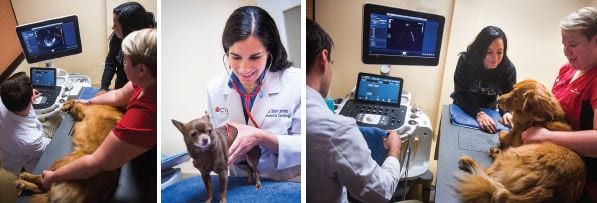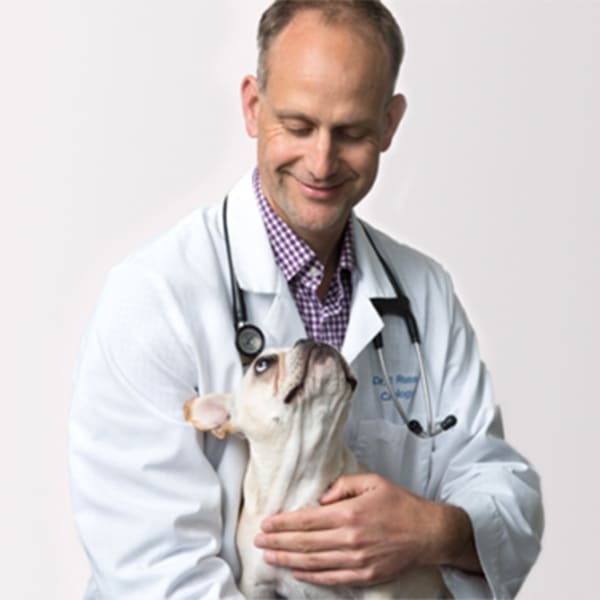How a Cancer Veterinary Near Me Offers Comprehensive Oncology Services for Pets}
Wiki Article
The Duty of Ultrasound and CT Scan in Modern Vet Practices: Insights From Experienced Professionals
In modern-day vet techniques, ultrasound and CT scans substantially enhance analysis capabilities. These imaging techniques provide critical understandings right into animal health and wellness, assisting treatment decisions. Experienced professionals recognize the special advantages of each modality. Ultrasound provides real-time evaluations, while CT scans deliver complex physiological details. Understanding their applications and functions elevates vital questions regarding their influence on person outcomes and the future of vet diagnostics. What understandings can be gained from their combined use?Comprehending Ultrasound in Vet Medicine
Ultrasound is a necessary diagnostic device in vet medicine, using a non-invasive approach to visualize inner frameworks. This imaging method uses high-frequency acoustic waves to develop real-time photos of tissues and organs, allowing veterinarians to examine conditions without surgical intervention. Typical applications include assessing the heart, liver, kidneys, and reproductive body organs, as well as keeping an eye on pregnancies.The treatment is relatively quick and can be executed in different setups, making it an easily accessible alternative for veterinarians. Unlike radiography, ultrasound provides comprehensive details regarding soft cells and blood circulation, which is important for precise diagnoses.Veterinary specialists depend on ultrasound to spot abnormalities such as lumps, cysts, and fluid build-up. Its capability to guide biopsies and other procedures further boosts its utility in scientific technique. By supplying a efficient and risk-free way to take a look at inner composition, ultrasound has actually become a foundation of modern-day veterinary diagnostics.
The Benefits of CT Checks for Animal Diagnostics
CT scans deal significant advantages in vet diagnostics by supplying enhanced precision in determining inner problems (Cancer Veterinary Near Me). As a non-invasive imaging strategy, they ensure the safety and security and convenience of animals during examinations. Furthermore, CT scans facilitate an extensive analysis of interior structures, enabling for much more reliable therapy preparationBoosted Diagnostic Accuracy
Advancements in imaging technology have significantly improved analysis precision in vet medication, specifically via using CT scans. These scans offer comprehensive cross-sectional images of an animal's internal structures, permitting veterinarians to identify problems with accuracy. The high resolution and three-dimensional capabilities of CT imaging help with the discovery of problems such as growths, fractures, and internal blood loss that may be missed with conventional imaging methods. Additionally, CT scans can assist in pre-surgical planning by supplying a thorough sight of anatomical connections. This level of information not only boosts the precision of diagnoses however likewise help in tailoring efficient therapy plans. As a result, the integration of CT innovation into vet techniques is changing the landscape of animal health care, improving end results for clients.Non-Invasive Imaging Strategy
The introduction of non-invasive imaging methods has actually reinvented pet diagnostics, with CT scans becoming a famous device in vet practices. These scans offer high-resolution, cross-sectional pictures of an animal's interior structures, enabling veterinarians to examine complex problems without the demand for intrusive treatments. The benefits of CT scans include their capacity to spot growths, fractures, and inner blood loss with exceptional accuracy. Furthermore, they assist in the assessment of soft tissues and organs, boosting diagnostic capabilities. The rate of CT scanning enables quick decision-making, which is important in emergency circumstances. By decreasing anxiety and discomfort for the animal, CT scans add to a more humane technique to diagnostics, inevitably enhancing therapy outcomes and advancing vet treatment.Comprehensive Internal Evaluation
A complete internal assessment is essential for accurate diagnosis and effective treatment in veterinary medicine. CT checks deal considerable benefits hereof, supplying in-depth cross-sectional pictures of an animal's internal structures. This advanced imaging technique improves visualization of complex physiological areas, allowing veterinarians to determine irregularities such as lumps, fractures, and inner bleeding with better accuracy. Additionally, CT scans facilitate the assessment of problems that might be testing to diagnose with conventional techniques. The speed and precision of CT imaging likewise add to prompt interventions, enhancing person end results. As veterinary methods progressively incorporate CT modern technology, the advantages of extensive inner assessments end up being obvious, enhancing the importance of this tool in modern-day vet diagnostics.Contrasting Ultrasound and CT Imaging Techniques
While both ultrasound and CT imaging serve important functions in veterinary diagnostics, each strategy uses unique benefits and restrictions that can influence clinical decision-making. Ultrasound is specifically valued for its real-time imaging capabilities, permitting veterinarians to observe dynamic physical processes. This technique is non-invasive, mobile, and does not include ionizing radiation, making it a much safer alternative for both clinicians and pets. Ultrasound might have limitations in picturing certain physiological structures or deep tissues.Conversely, CT imaging supplies thorough cross-sectional views of the body, allowing for exact localization of abnormalities. It stands out in reviewing facility organs and frameworks, especially in the thorax and abdominal area. CT scans need sedation or anesthetic in numerous instances and entail exposure to ionizing radiation. Inevitably, the selection between ultrasound and CT relies on the specific professional circumstance, the location of rate of interest, and the urgency of the diagnostic requirements.Case Researches: Effective Medical Diagnoses Via Imaging
Study highlight the considerable enhancements in analysis accuracy attained through innovative imaging innovations like ultrasound and CT scans in veterinary techniques. These improvements not only boost the discovery of various conditions yet likewise help with efficient and prompt treatment plans. Examining specific cases can highlight the transformative impact of these imaging techniques on veterinary medicine.Analysis Accuracy Improvements

Imaging Modern Technology Advancements
As veterinary imaging innovation remains to progress, its influence on diagnostic abilities becomes significantly noticeable. Current study highlight the successful application of advanced ultrasound and CT check strategies in identifying intricate conditions. For circumstances, a veterinary center utilized high-resolution CT scans to diagnose an uncommon form of lung cancer cells in a canine, which traditional imaging had actually missed out on. Similarly, an ultrasound exam disclosed an abdominal mass in a feline, prompting prompt medical intervention and a positive end result. These developments not just boost diagnostic precision yet additionally allow vets to develop targeted treatment plans. By leveraging advanced imaging innovations, vet experts are significantly enhancing person treatment, causing much more effective monitoring of different wellness conditions in animals.
The Function of Imaging in Emergency Veterinary Treatment
Imaging plays a necessary function in emergency situation vet treatment, giving veterinarians with vital information needed to make quick, enlightened choices. In urgent situations, methods like ultrasound and CT scans make it possible for professionals to swiftly evaluate an animal's interior structures, determining crucial problems such as interior bleeding, fractures, or organ problems. These imaging techniques enable real-time assessments, assisting in prompt treatments that can be life-saving. Ultrasound is indispensable for assessing soft cells injuries and conditions like fluid build-up, while CT scans deal comprehensive images of complex anatomical frameworks, essential for identifying trauma instances. The speed and accuracy of these imaging methods improve the vet's ability to develop effective treatment strategies, ensuring the most effective feasible results for their clients. Consequently, the assimilation of innovative imaging innovations into emergency vet methods is not just valuable but significantly needed, as it enhances analysis capabilities and enhances overall animal care throughout critical minutes.Training and Proficiency in Vet Imaging
Innovative imaging techniques such as ultrasound and CT scans are necessary for reliable veterinary care, the effective execution of these technologies greatly depends on the training and competence of veterinary experts. Skillful usage of imaging tools requires complete expertise of makeup, pathology, and the concepts underlying each modality. Veterinary professionals have to undergo specialized training to accurately interpret imaging results, which is important for identifying problems and planning treatment.Certifications and continuing education in vet imaging boost the abilities of practitioners, enabling them to remain upgraded with technical innovations. Cooperation in between radiologists and vets usually leads to improved analysis precision, as experts can supply insights into complex cases. Furthermore, sensible experience in taking care of imaging tools cultivates self-confidence in its application. Eventually, the high quality of veterinary imaging services is straight correlated to the level of training and knowledge possessed by the specialists making use of these necessary diagnostic tools.Future Trends in Diagnostic Imaging for Animals
With the quick innovations in modern technology, vet analysis imaging is poised for significant evolution in the coming years. Arising patterns indicate a change towards more mobile and available imaging methods, such as portable ultrasound devices, which can boost field diagnostics. In addition, the integration of expert system is expected to transform image analysis, permitting quicker and much more exact interpretations of results.Moreover, advancements in 3D imaging strategies and computed tomography will certainly offer vets with more detailed views of pet anatomy, leading to enhanced therapy plans. Digital truth modern technology may also play a duty in surgical preparation and education and learning, providing vets a distinct viewpoint on complex cases.As telemedicine remains to expand, remote assessments promoted by diagnostic imaging will end up being more typical, enabling professionals to assist basic experts in real-time. In general, these patterns are established to enhance the effectiveness and performance of vet care, ultimately boosting pet outcomes.Often Asked Inquiries
Just How Much Do Ultrasound and CT Checks Expense in Vet Facilities?
The prices of ultrasound and CT scans in veterinary clinics usually vary from $300 to $1,500, relying on variables such as area, clinic type, and specific procedures required for the animal's diagnosis and treatment.
Exist Any Type Of Risks Linked With Ultrasound and CT Scans for Pets?
Ultrasound and CT scans normally position marginal dangers to pet dogs. Potential worries consist of sedation reactions and direct exposure to anesthetics. Vets very carefully assess each situation to minimize any type of threats associated with these diagnostic treatmentsThe Length Of Time Do Ultrasound and CT Treatments Generally Take?
Ultrasound treatments usually take about half an hour to an hour, relying on the intricacy. CT scans, being more in-depth, generally need 30 mins to 90 mins, including preparation and healing time for the pet dog.Can All Veterinarians Perform Ultrasounds and CT Scans?
Not all veterinarians can carry out ultrasounds and CT scans. Specialized training and accreditation are usually required to ensure proficiency in these innovative imaging methods, which might restrict their schedule to veterinarians with additional qualifications and resources.What Kinds Of Pets Profit A Lot Of From These Imaging Techniques?
Particular pet varieties, specifically cats and canines, benefit significantly from ultrasound and CT scans. These imaging methods improve analysis accuracy for conditions like growths, interior injuries, and body organ abnormalities, bring about enhanced therapy outcomes and person care. The high resolution and three-dimensional capabilities of CT imaging promote the detection of conditions such as tumors, cracks, and inner blood loss that may be missed with conventional imaging techniques. Case studies illustrate the substantial renovations in analysis accuracy achieved via innovative imaging modern technologies like ultrasound and CT scans in vet practices. Improving diagnostic precision in veterinary practices has actually been substantially helped by developments in imaging innovations such as ultrasound and CT scans. Advanced imaging strategies such as ultrasound and CT scans are crucial for efficient veterinary treatment, the successful implementation of these technologies greatly depends on the training and experience of veterinary experts. Veterinary experts should undergo customized training to precisely interpret imaging outcomes, which is vital for detecting problems and planning treatment.Certifications and proceeding education in vet imaging enhance the abilities of practitioners, allowing them to stay upgraded with technological improvements.Report this wiki page